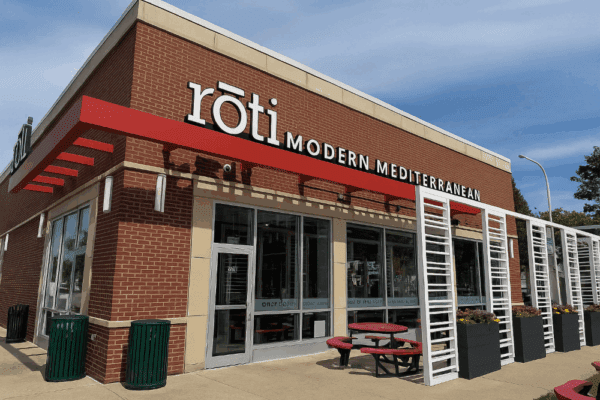Edible Brands operates both corporate-owned and franchised Edible Arrangements shops, however these brick-and-mortar areas have a few essential distinctions from various other sort of specialized retail. As a matter of fact, they’re better in kind to takeout-heavy quick laid-back restaurants– which Edible Brands additionally runs, in the form of the Rōti chain of build-your-own-meal-style dining establishments (think Chipotle with Mediterranean food).

“The right way to consider the [Edible Arrangements] version is as an ecommerce company that has [stores as] satisfaction centers ,” said Edible Brands Head of state and Chief Stores Officer Matthew Walls in a meeting with Retail TouchPoints “About 80 % of the business undergoes electronic ways and after that it’s delivered, and normally not to the person that bought it, [since it’s generally a gift purchase] What I have to think of is how I maximize the staying 20 % of that organization.”
Such an organization model calls for a mindful approach to site selection, both for Edible Setups and for Rōti. Edible Brands currently runs 17 Rōti restaurants, in Chicago, Washington, D.C. and Minnesota, and is seeking to increase development for both this banner and for Edible Setups.
Wall surfaces went over Edible Brands’ strategy to realty in addition to the numerous impacts that website selection and store design can have on everyday procedures.
Retail TouchPoints (RTP): Given the delivery-heavy nature of the Edible Plans organization, what are several of the most important things you’re seeking in regards to website choice?
Matthew Walls: Basically what we’re searching for is a place that’s practical for individuals to see and is also an excellent area to supply from. My professional job started in geospatial mapping at General Electric , so I’m partial to the analytics item, and applying AI and psychographics to it. When we see a [potential] location, we toss it into the system to see whether we can be effective or not there. We do this for both corporate-owned stores and franchise business
We’re constantly trying to find good real estate with great exposure as well as great accessibility to shipment paths We need to check out egress and traffic flow– for example, you don’t want a location that’s extremely active from 5 p.m. to 8 p.m. [when many deliveries are scheduled] We also such as to have high transactional co-tenants around, because we do rely upon some carryout organization

RTP: What are the realty priorities for the Rōti locations?
Wall surfaces: Like the majority of our fast casual competitors in this build-your-own specific niche, a big lunchtime group will usually turn up, so we look for power centers [real estate-speak for larger shopping centers] that are close to office complex. The Rōti stores we bought in February are mainly in central downtown, such as downtown Chicago, to obtain that workplace website traffic. Yet an expanding trend that we’re seeing in more suburban centers is that while lunch [traffic is light], the afternoon and night day components give a wonderful bump. I’m confident that we can considerably broaden out of the metropolitan niche with Rōti.
RTP: What do you view as Edible Brands’ duty during the construction/buildout phases of a brand-new place?
Wall surfaces: For corporate-owned shops, we run whatever– my property, building and construction and design groups are extremely hands-on, handling the contractors and the designers and then collaborating with local towns. For franchisees, my task is really as an expert; the franchisee finds fantastic property and deals with the basic specialist. If I see things falling behind, I can ask the franchisee, “Do you need us to whisper into your general professional’s ear?,” yet I favor to enlighten and inform the franchisees. We’re experienced sufficient to visit the general service provider or really anyone in their ecosystem, and there are approvals we need to give, yet largely I’m running as a professional.
RTP: How around after the stores open? What are some common difficulties?
Walls: We need to think about the client journey for the 20 % of business [that’s not delivery] That indicates it requires to be really simple to enter and out, as well as reducing any rubbing it would consider consumers to get what they have actually currently purchased or to purchase something. We also desire that [shopping area] to appear like it’s actually being merchandised– that we’re not just placing all the stuff we carry in advance. It’s difficult to narrate when the shelves are overly packed with items.
Our next-generation Edible Plans save , located in North Haven, Conn., has actually a revamped store that’s meant to be even more of a selling room versus a “pick-up counter.” It utilizes lighter woods and more focused illumination in addition to updated graphics. We’ve understood that indeed, we are a fulfillment center for ecommerce, yet we do have all these various other offerings, like healthy smoothies, cheesecake and cookies.
Another aspect entails third-party distribution orders. At a Rōti, as an example, I actually don’t desire distribution chauffeurs to twist with the eating area or reduce the [customer] queue. I acquired shops that weren’t developed [to circumvent that], yet with any brand-new Rōti building, the [delivery driver] accessibility point will certainly be close to the POS system, in order to keep track of that the right individuals are grabbing the best order. Design principles are always concerning circulation and reducing rubbing.
RTP: How do you use style to show the community where these shops operate?
Walls: At any time you can bring some neighborhood significance right into a design, it makes a lots of sense. It’s not simply spraying the city’s name on the wall surface; you wish to make use of aspects from the location. As an example, with Rōti’s Lincoln Park location in Chicago, it’s all glass and very brilliant, with Mediterranean floor tile to lead consumers via the line. In other urban locations we have actually use even more steel and refined concrete floorings, with darker colors and high ceilings. That’s what’s enjoyable about the Rōti side: as long as I have concerning 600 square feet for the operational facility of the shop, I can have a good time with the remainder of it.
RTP: What are other methods layout impacts exactly how Edible Brands’ stores operate?
Walls: A lot of rooms are made for guests/customers and not for employee. I discovered early in my career that if your staff member are forgotten– if your ambassador to the visitor doesn’t have a proper area where they can blow off vapor [if they’re having a problem] and after that collect themselves, for example– they can not be their ideal selves for the guest.